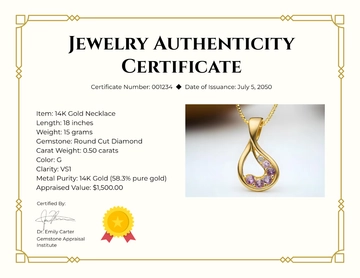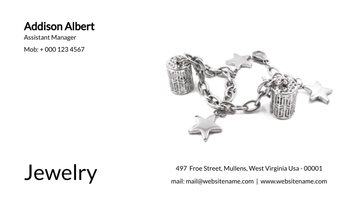Free Jewelry Store Management

I. Introduction
Welcome to the comprehensive management guide for [Your Company Name], a premier jewelry store dedicated to providing exceptional quality and service to our customers. As a trusted establishment in the jewelry industry, we understand the importance of maintaining high standards in both product offerings and customer interactions. This guide is designed to provide our staff and management team with the necessary tools and protocols to operate efficiently while complying with all relevant US laws and industry standards.
In an ever-evolving market, [Your Company Name] remains committed to excellence through continuous improvement and innovation. Our management strategies encompass all facets of the business, including inventory management, customer service, employee training, and marketing. By adhering to these practices, we not only enhance customer satisfaction but also foster a positive work environment that motivates our team. Our goal is to ensure that every piece of jewelry sold not only meets but exceeds customer expectations, solidifying our reputation as a leader in the jewelry sector. Together, we strive to create a memorable shopping experience that reflects our dedication to quality and integrity.
II. Key Responsibilities
A. Inventory Management
Proper inventory management is crucial for the success of a jewelry store. By implementing effective practices, store managers can minimize losses, ensure adequate stock levels, and respond swiftly to market demand. Below are key responsibilities for effective inventory management:
Conduct Regular Inventory Audits: Schedule audits monthly to assess stock levels, identify discrepancies, and ensure accurate record-keeping.
Automate Stock Tracking: Utilize inventory management software to track sales, manage orders, and generate reports, streamlining the process and reducing human error.
Establish Supplier Relationships: Build strong partnerships with reliable suppliers to ensure timely deliveries, negotiate better pricing, and secure high-quality materials.
B. Staff Training and Management
A well-trained staff is essential to delivering exceptional customer service and boosting sales. Continuous training and effective management practices empower employees to perform at their best and adapt to the evolving market. Key responsibilities include:
Hire Skilled Personnel: Prioritize hiring individuals with relevant experience and a passion for customer service in the jewelry industry.
Conduct Regular Training Sessions: Organize training workshops focused on sales techniques, customer engagement, and product knowledge to enhance employee skills.
Implement a Performance Appraisal System: Develop a structured appraisal process to evaluate employee performance, set goals, and identify areas for improvement, fostering career development.
III. Customer Service
A. Personalized Experience
A personalized customer experience is vital for fostering loyalty and increasing sales. By focusing on individual customer needs and preferences, jewelry stores can create a welcoming environment that encourages repeat visits. Key elements include:
Establish Customer Profiles: Collect information on customer preferences, purchase history, and special occasions to tailor recommendations and services.
Maintain Communication: Use email, newsletters, and social media to keep customers informed about new products, promotions, and upcoming events, enhancing engagement.
Follow Up on Purchases: Reach out to customers after a purchase to express gratitude, offer care tips for their jewelry, and inquire about their satisfaction, demonstrating commitment to their experience.
B. Customer Feedback
Encouraging and utilizing customer feedback is essential for understanding client needs and refining services. Actively seeking input helps ensure that the store meets customer expectations and adapts to market trends. Key strategies include:
Solicit Customer Feedback: Create opportunities for customers to share their thoughts through surveys, comment cards, or online reviews, making it easy for them to express their opinions.
Analyze Feedback: Regularly review feedback to identify patterns and insights regarding products, services, and customer experiences, guiding future business decisions.
Update Services Regularly: Use customer insights to inform changes in inventory, pricing, and service offerings, demonstrating responsiveness to customer needs and preferences.
IV. Sales Strategies
A. Marketing and Promotions
Effective marketing strategies are essential for increasing visibility and attracting new customers to the jewelry store. By leveraging various channels, stores can reach a broader audience and enhance brand recognition. Key approaches include:
Utilize Social Media: Engage customers on platforms like Instagram, Facebook, and Pinterest by sharing high-quality images, stories, and promotions. Consider paid advertising to target specific demographics.
Email Marketing: Develop an email marketing campaign to keep customers informed about new arrivals, exclusive deals, and upcoming events, fostering a direct line of communication.
In-Store Promotions: Organize events such as trunk shows or holiday sales to draw foot traffic and create buzz around the store, offering customers unique shopping experiences.
B. Loyalty Programs
Implementing rewarding loyalty programs is an effective way to retain customers and encourage repeat business. By offering incentives, stores can foster long-term relationships and increase customer satisfaction. Key elements include:
Special Discounts: Provide tiered discounts based on purchase history, allowing customers to enjoy savings as they shop more frequently.
Exclusive Offers: Create limited-time offers for loyalty program members, such as complimentary services (e.g., cleaning or repairs) or special gifts with purchase, enhancing the shopping experience.
Early Access to New Collections: Allow loyal customers to preview and purchase new collections before they are available to the general public, making them feel valued and appreciated.
V. Security and Loss Prevention
Ensuring the security of the jewelry store and its inventory is paramount in maintaining operational integrity and customer trust. By implementing robust security measures and protocols, the store can effectively minimize the risk of theft and fraud. Key strategies include:
Equip with Advanced Surveillance Systems: Install high-definition cameras throughout the store to monitor customer interactions and deter potential theft. Ensure that the surveillance system covers all entrances, exits, and critical areas, with footage stored securely for future reference.
Maintain Strict Access Control: Limit access to sensitive areas, such as storage rooms and cash registers, by using keycard systems or biometric access controls. Train employees on the importance of securing these areas and encourage them to report any suspicious behavior.
Conduct Regular Security Audits: Schedule routine security audits to assess vulnerabilities in the store's operations. This includes reviewing security footage, evaluating access controls, and analyzing inventory discrepancies to identify areas for improvement.
Implement Employee Training Programs: Provide training sessions for employees on recognizing suspicious behavior, reporting protocols, and emergency procedures. This ensures that staff members are prepared to respond effectively to potential security threats.
Establish a Clear Incident Response Plan: Develop a comprehensive plan outlining the steps to take in the event of a theft, break-in, or other security breaches. Ensure that all employees are familiar with this plan and conduct regular drills to reinforce preparedness.
VI. Testimonials
Testimonials from our team and partners highlight the effectiveness of our management strategies in driving success at [Your Company Name]. These insights reflect our commitment to excellence in customer service, inventory management, and employee training, showcasing how our practices contribute to a thriving jewelry store environment.
"The training and staff management practices were instrumental in achieving our sales targets and delivering exceptional customer service." — Karl Delcom, Store Manager |
"Implementing a robust inventory system has significantly reduced our losses and improved our supply chain efficiency." — Xyza Gents, Operations Director |
VII. Conclusion
Efficient jewelry store management requires a multifaceted approach that encompasses various critical elements, including diligent inventory control, effective staff management, personalized customer service, innovative sales strategies, and stringent security measures. Each of these components plays a vital role in ensuring that the store operates smoothly while meeting the expectations of customers and stakeholders alike. By implementing best practices in these areas, managers can create a harmonious environment that not only enhances operational efficiency but also promotes a positive shopping experience.
Moreover, the jewelry industry is continuously evolving, making it essential for store managers to remain adaptable and responsive to market trends. Emphasizing ongoing staff training and customer engagement helps to build loyalty and trust, which are indispensable for long-term success. By following these guidelines and fostering a culture of excellence at [Your Company Name], store managers can effectively navigate challenges and seize opportunities, ultimately positioning the store as a leader in the competitive jewelry market. The commitment to quality management will pave the way for sustained growth and customer satisfaction.
- 100% Customizable, free editor
- Access 1 Million+ Templates, photo’s & graphics
- Download or share as a template
- Click and replace photos, graphics, text, backgrounds
- Resize, crop, AI write & more
- Access advanced editor
Streamline your operations with this Jewelry Store Management Template from Template.net. This customizable and editable template provides a comprehensive framework for managing inventory, sales, and customer relations. Fully editable in our Ai Editor Tool, you can tailor each section to fit your specific business needs, ensuring efficient and effective management of your jewelry store.





























